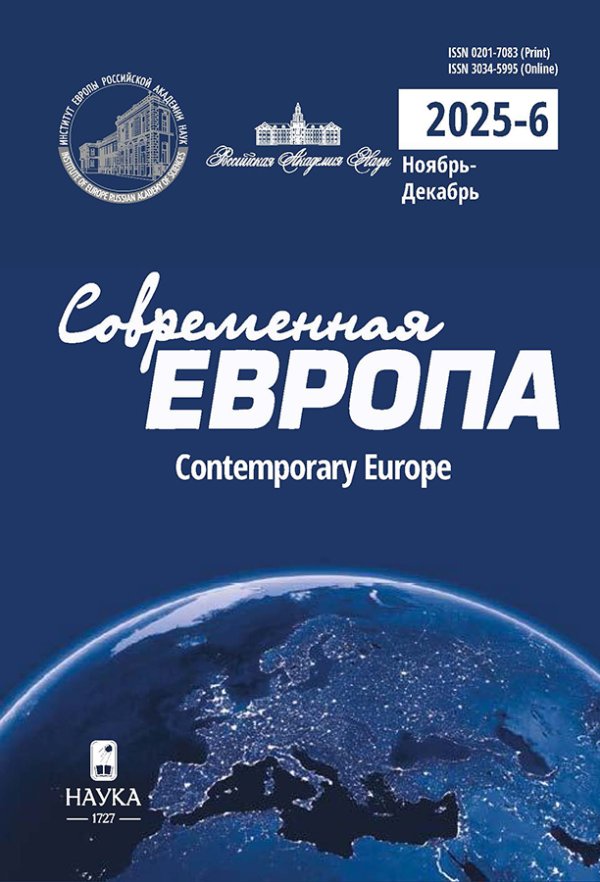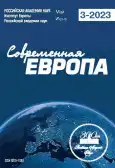The impact of the EU enlargement on the speed of decision-making
- Authors: Kaveshnikov N.Y.1,2, Domanov A.O.2
-
Affiliations:
- MGIMO-University
- Institute of Europe Russian Academy of Sciences
- Issue: No 3 (117) (2023)
- Pages: 5-19
- Section: Articles
- URL: https://journals.rcsi.science/0201-7083/article/view/144480
- DOI: https://doi.org/10.31857/S0201708323030014
- EDN: https://elibrary.ru/BQBJUG
- ID: 144480
Cite item
Full Text
Abstract
About the authors
Nikolay Yur'evich Kaveshnikov
MGIMO-University;Institute of Europe Russian Academy of Sciences
Email: nikandrrr@mail.ru
Moscow, Russia
Alexey Olegovich Domanov
Institute of Europe Russian Academy of Sciences
Email: domanov.aleksey@gmail.com
References
- Кавешников Н.Ю. (2021a) Анализ влияния Европейского парламента и Совета ЕС на примере реформы Системы торговли парниковыми газами. Мировая экономика и международные отношения. Т. 65. № 6. С. 21-32.
- Кавешников Н.Ю. (2021b) Обычная законодательная процедура в ЕС как пример кооперативных практик. Вестник МГИМО-Университета. № 14(1). С. 126-147.
- Кавешников Н.Ю., Доманов А.О. (2022) Скорость законодательного процесса в Европейском союзе. Количественный анализ. Международные процессы. Т. 20. № 1 (68). С. 80-108.
- Потемкина О.Ю. (2019) После кризиса: "новый старт" миграционной политики ЕС. Современная Европа. № 6. С. 18-29.
- Baldwin R.E., Widgren M. (2004) Council voting in the Constitutional Treaty: Devil in the details. CEPS Policy Brief 53. CEPS, Brussels, Belgium. 8 p.
- Banzhaf J.F. (1965) Weighted Voting Doesn't Work: A Mathematical Analysis.Rutgers Law Review. Vol. 19. P. 317-343.
- Best E., Settembri P. (2008) Surviving enlargement: How has the Council managed? The Institutions of the Enlarged European Union. Continuity and Change. Ed. by E. Best, T. Christiansen, P. Settembri. Edward Elgar, Cheltenham, UK. P. 34-53.
- Bølstad J., Cross J.P. (2016) Not all Treaties are Created Equal: The Effects of Treaty Changes on Legislative Efficiency in the EU. Journal of Common Market Studies. Vol. 54. No. 4. P. 793-808.
- Box-Steffensmeier J., Bradford J. (2004) Event History Modeling in Political Science. Cambridge University Press, Cambridge, UK. 218 p.
- Brandsma G.J. (2015) Co-decision after Lisbon: The politics of informal trilogues in European Union lawmaking. European Union Politics. Vol. 16. No. 2. P. 300-319.
- Buchanan J.M.G., Tullock G. (1965) The Calculus of Consent. Logical Foundations of Constitutional Democracy. University of Michigan Press, Ann Arbor, USA. 361 p.
- Cornes R., Sandler T. (1996) The Theory of Externalities, Public Goods, and Club Goods. Cambridge University Press, Cambridge, UK. 590 p.
- Cox D.R. (1972). Regression Models and Life Tables (with Discussion). Journal of the Royal Statistical Society, Series B. Vol. 34. P. 187-220.
- Enelow J., Hinich M. (1984) The Spatial Theory of Voting: An Introduction. Cambridge University Press, Cambridge, UK. 238 p.
- Fox J. (2015) Applied regression analysis and generalized linear models. SAGE Publications, Thousand Oaks, USA. 816 p.
- Geddes A. (2018) The Politics of European Union Migration Governance. Journal of Common Market Studies. Vol. 56. Issue 51. P. 120-130.
- Golub J. (2007) Survival Analysis and European Union Decision-making. European Union Politics. Vol. 8. No. 2. P. 155-179.
- Golub J., Steunenberg B. (2007) How Time Affects EU Decision-Making, European Union Politics. Vol. 8. No. 4. P. 555-566.
- Hertz R., Leuffen D. (2011) Too big to run? Analysing the impact of enlargement on the speed of EU decision-making. European Union Politics. Vol. 12. No. 2. P. 193-215.
- Hilbe J. (2011) Negative Binomial Regression. Cambridge University Press, Cambridge, UK. 546 р.
- Imbens G.W., Lemieux T. (2008) Regression Discontinuity Designs: A Guide to Practice. Journal of Econometrics. Vol. 142. No. 2. P. 615-635.
- Jevnaker T., Wettestad J. (2017) Ratcheting Up Carbon Trade: The Politics of Reforming EU Emissions Trading. Global Environmental Politics. Vol. 17. No 2. P. 105-124.
- Klüver H., Sagarzazu I. (2013) Ideological congruency and decision-making speed: The effect of partisanship across European Union institutions. European Union Politics. Vol. 14. No. 3. P. 388-407.
- König T. (2007) Divergence or convergence? From ever-growing to ever-slowing European legislative decision-making. European Journal of Political Research. Vol. 46. P. 417-444.
- Mattila M. (2009) Roll call analysis of voting in the European Union Council of ministers after the 2004 enlargement. European Journal of Political Research. Vol. 48. No. 6. P. 840-857.
- Morgan S.L., Winship C. (2007) Counterfactuals and Causal Inference: Methods and Principles for Social Research. Cambridge University Press, N.Y., USA. 328 р.
- Plechanovova, B. (2011) The EU council enlarged: north-south-east or core-periphery? European Union Politics. Vol. 12. No. 1. P. 87-106.
- Steunenberg, B. (2002) An even wider Union: The effects of enlargement on EU decision-making. Widening the European Union: The Politics of Institutional Change and Reform. Ed. by B. Steunenberg. Routledge, London, UK. P. 97-118.
- Thomson R. (2009) Actor alignments in the European Union before and after enlargement. European Journal of Political Research. Vol. 48. No. 6. P. 756-781.
- Thomson R., Arregui J., Leuffen D., Costello R., Cross J., Hertz R., Jensen T. (2012) A new dataset on decision-making in the European Union before and after the 2004 and 2007 enlargements (DEUII). Journal of European Public Policy. Vol. 19. No. 4. P. 604-622.
- Thomson R. (2009) Actor alignments in the European Union before and after enlargement. European Journal of Political Research. Vol. 48. No. 6. P. 756-781.
- Toshkov D. (2017) The impact of the Eastern enlargement on the decision-making capacity of the European Union. Journal of European Public Policy. Vol. 24. No. 2. P. 177-196.
- Toshkov D., Rasmussen A. (2012) Time to decide: The effect of early agreements on legislative duration in the EU. European Integration Online Papers. Vol. 16. No. 11. pp. 1-20.
- Tsebelis G. (2002) Veto players: How political institutions work. Sage, N.Y., USA. 317 p.
- Veen T. (2011) The dimensionality and nature of conflict in European Union politics: On the characteristics of intergovernmental decision-making. European Union Politics. Vol. 12. No. 1. P. 65-86.
- Wallace H., Pollack M., Young A. (ed) (2015) Policy-Making in the European Union. Oxford University Press, Oxford, UK. 575 p.
- Youngs R. (2020) EU foreign policy and energy strategy: bounded contestation. Journal of European Integration. Vol. 42. No. 1. P. 147-162.
- Zimmer C., Schneider G., Dobbins M. (2005) The contested Council: Conflict dimensions of an intergovernmental EU institution. Political Studies. Vol. 53. P. 403-422.
- Zorn Ch. (2007). Temporal Change and the Process of European Union Decision-Making. European Union Politics. Vol. 8. No. 4. P. 567-576.
Supplementary files










